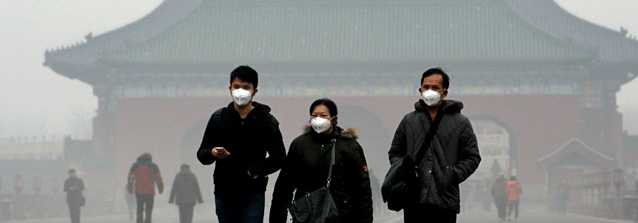World to Cut Gas Emissions by 25 Percent More Than Paris Agreement

ROME, Nov 04 (IPS) - On the eve of the entry into force of the Paris Agreement today Nov. 4, the United Nations sounded new climate alarm, urging the world to ‘dramatically' step up its efforts to cut greenhouse gas emissions by some 25 per cent more.
The United Nations Environment Programme (UNEP), in its Emissions Gap report 2016, warned that the world must urgently act to cut a further 25 per cent from predicted 2030 emissions "to meet the stronger, and safer, target of 1.5 degrees Celsius" global temperature rise.
"The world is still heading for temperature rise of 2.9 to 3.4 this century, even with the pledges made last December by States Parties to the UN Framework Convention on Climate Change (UNFCCC), according to UNEP.
"This means we need to find another one degree from somewhere to have any chance of minimizing dangerous climate change." UNEP made the announcement in London as it released its annual Emissions Gap report, which found that 2030 emissions are expected to reach 54 to 56 gigatonnes of carbon dioxide equivalent. The projected level needed to keep global warming from surpassing 2°C this century is 42 gigatonnes.
 Credit: UNEPIn early October, the Paris Agreement on climate change cleared the final threshold of 55 countries representing 55 per cent of global emissions required for the accord to enter into effect, now set for tomorrow.
Credit: UNEPIn early October, the Paris Agreement on climate change cleared the final threshold of 55 countries representing 55 per cent of global emissions required for the accord to enter into effect, now set for tomorrow.
The next meeting of Parties to the UNFCCC, known widely as COP 22, kicks off Monday Nov. 7 in Marrakech, Morocco.
Scientists around the world agree that limiting global warming to 2°C this century (compared to pre-industrial levels) would reduce the probability of severe storms, longer droughts, rising sea levels and other devastating climate-related events, says the report.
"However, they caution that even a lower target of 1.5°C will reduce rather than eliminate impacts."
Erik Solheim, UNEP executive director, said in a new release that while the Paris Agreement and the recent Kigali Amendment to the Montreal Protocol to reduce hydro-fluorocarbons (HFCs), are steps in the right direction, the strong commitments are nevertheless still not enough.
Since 2010, UNEP has produced annual Emissions Gap Reports based on requests by countries for an independent scientific assessment of how actions and pledges by states affect the global greenhouse gas emissions trend, and how this compares to emissions trajectories consistent with the long-term goal of the United Nations Framework Convention on Climate Change.
"If we don't start taking additional action now, beginning with the upcoming climate meeting in Marrakech, we will grieve over the avoidable human tragedy. The growing numbers of climate refugees hit by hunger, poverty, illness and conflict will be a constant reminder of our failure to deliver," the UNEP chief said.
That stark warning echoed his call from the report's forward, where he said: "None of this will be the result of bad weather. It will be the result of bad choices by governments, private sector and individual citizens. Because there are choices The science shows that we need to move much faster."
2015 was the hottest year ever recorded and the first six months of 2016 have thus far broken all prior records. Yet the report finds that emissions continue to increase.
Last month, the Kigali Amendment to the Montreal Protocol agreed to slash the use of HFCs. According to preliminary studies, this could lead to a cut in 0.5½ °C if fully implemented, although significant reductions will not be realised until 2025.
Collectively, members of the Group of 20 most industrialised countries (G20) are on track to meet their Cancun Agreements for 2020, but these pledges fall short of a realistic starting point that would align targets with the Paris Agreement, according to UNEP.
Fortunately, the report has found, through technology and opportunity assessments, a number of ways for States and non-State actors to implement further cuts that would make the goals achievable, including energy efficiency acceleration and crossover with the Sustainable Development Goals (SDGs).
For example, non-State actors, including those in the private sector, cities, and citizen groups, can help to reduce several gigatonnes by 2030 in areas such as agriculture and transport.
Energy efficiency is another opportunity; a 6 per cent increase in investments last year (a total of 221 billion dollars) in the industry indicates that such action is already happening, it adds.
 Credit: UNEP
"Moreover, studies have shown that an investment of 20 to 100 dollars per tonne of carbon dioxide would lead to reductions (in tonnes) of 5.9 for buildings, 4.1 for industry, and 2.1 for transport by 2030."
Credit: UNEP
"Moreover, studies have shown that an investment of 20 to 100 dollars per tonne of carbon dioxide would lead to reductions (in tonnes) of 5.9 for buildings, 4.1 for industry, and 2.1 for transport by 2030."
The 1 Gigaton Coalition, created by UNEP with the support of the government of Norway in 2014, recently found that implementing renewable energy and energy efficiency projects in developing countries from 2005 to 2015 will lead to a half gigatonne reduction in emissions by 2020. This includes actions taken by countries that have not made formal Cancun pledges.
© Inter Press Service (2016) — All Rights ReservedOriginal source: Inter Press Service
 Global Issues
Global Issues